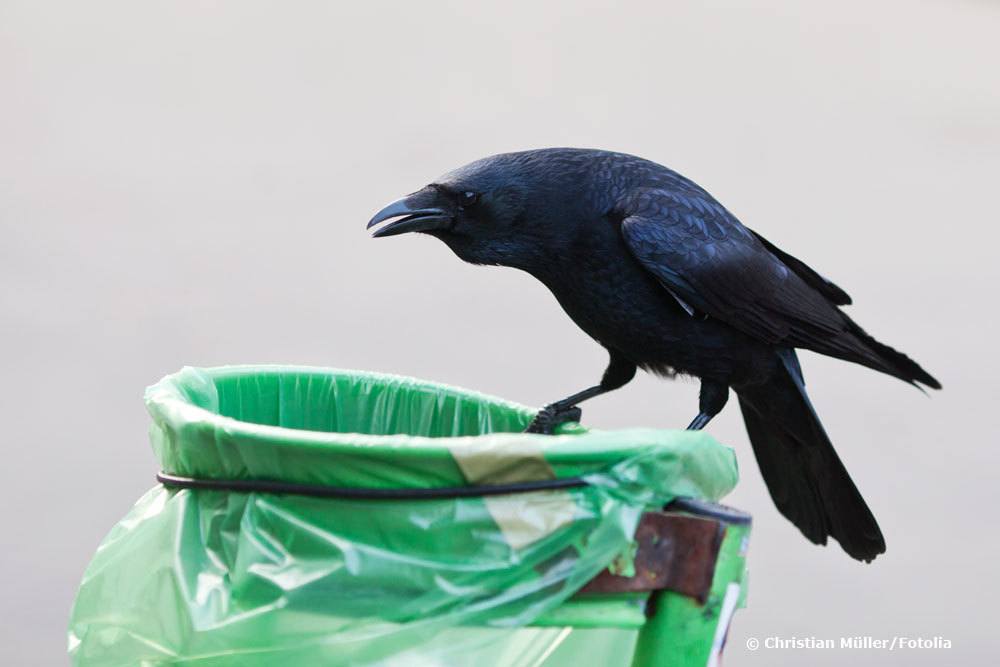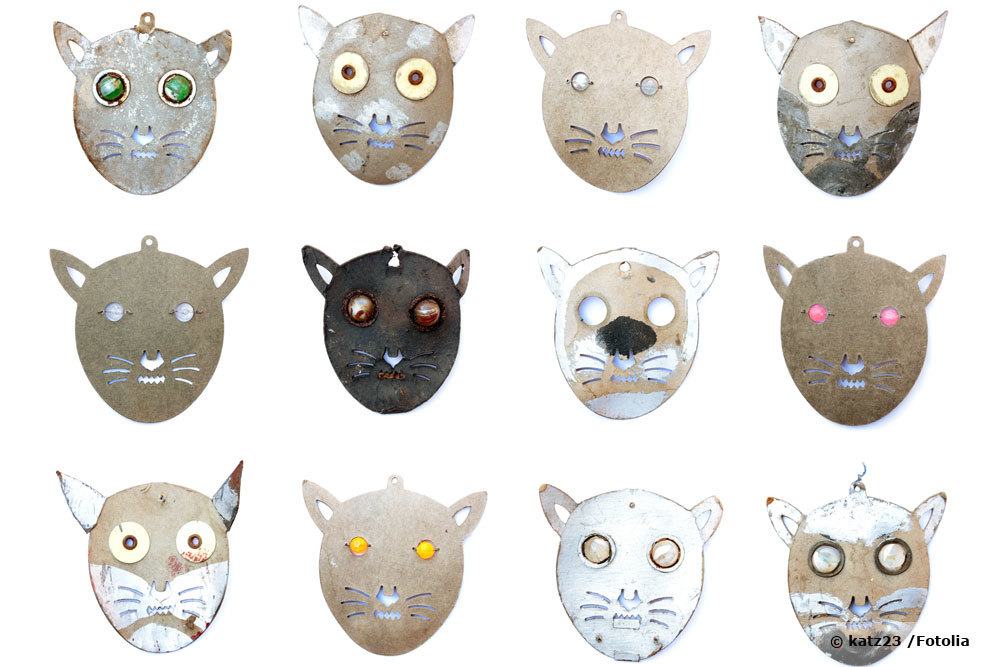Crows and ravens belong to the genus Corvus from the family of corvids (Corvidae). They are considered a nuisance, especially in residential areas. They are not only noisy, but can also cause immense, costly damage. In addition, they drive away songbirds with their melodic sounds. All the more important that the black birds are not granted a stay in the home garden. Here you can learn how to effectively drive them away.
Contents
Crows – the enemy in the garden
Crows and ravens are black and quite large. They are conspicuous by loud, sharp sounds, and especially the mating call can not be ignored. They are very intelligent and resourceful birds. They are specialized in tricking their surroundings. They learn immensely fast and are not satisfied with a “can’t do”. This can be observed especially when it comes to eating. Here they are always finding new ways to get to even the most inaccessible food source. If they are in the garden, there is hardly any food left for most of the rest of other bird species. These then stay away, especially since ravens and crows do not shy away from “territorial fights”, in which smaller birds are strongly inferior to them. To make matters worse, they also help themselves to the brood of popular and rare bird species.
Drive away crows and ravens
Driving away is difficult
Due to their intelligence and engaging nature, they usually cannot be driven away with simple measures and especially not in the long term. If they find preferred conditions with food in gardens, they usually stay and cannot be driven away so easily. In this case, action is needed in various directions to make their stay in the near environment as difficult and unattractive as possible.
Measures to drive away crows
Avoid food access
crows do not stop at lids, plastic or similar packaging materials. They use their sharp beaks to peck open coverings and can lift objects. If they can no longer reach food, the chances increase immensely that they will move away and ideally not settle in your garden area in the first place. You should take the following measures accordingly:
- Always keep trash cans tightly closed
- Do not leave freely accessible garbage bags lying around
- Protect small garbage cans from tipping over
- Cover compost heaps
- Cover vegetable beds and fruit plants with netting
- Remove fallen fruit immediately

Tip: In summer, make sure that the bird net has sufficiently large holes so that small birds can get to the insects near the cherry or berry. Ten centimeters of hole diameter should not be exceeded.
Adapt feeding stations
Especially in winter, birdhouses attract the corvus species. Here you rob the songbirds of food. In principle, it is advisable to do without bird feeders in winter if a raven or crow is already flying around. Although you will then also have to do without the approach of songbirds, the chances are much better that this will only apply to this one winter, because the corvids will move on if they do not find anything to eat.
If you still want to use feeders, there are a few details you should keep in mind:
Use only self-closing feeders
Make sure the openings are small so that corvids cannot get through them.
Restrict the distribution of food only to the closed, not freely accessible area.
Nesting sites
Protect nesting sites of other bird species
Nesting sites of small songbirds are especially attractive to corvidae. Once located, they stick their heads into the nest and feed on the after-brood. Subsequently, they memorize the food source and chances are high that they will check in regularly to see if filled nests are available. This can go on for several years if they are not discouraged from nest predation. Here’s what you can do to help:
Spread out several nest boxes.
These should have at least 15 centimeters between the entrance hole and the ground
The nesting hole should have a diameter of less than 15 centimeters
Use the nesting sites of crows to drive them away.
If the crows have built a nest, they have officially moved into the garden and are now in their “home”, from which they are reluctant to be chased away again. There are a few tricks you can use to make it more difficult for them to build a nest and/ or access the nest:
Cut off all dead and dried branches on trees and shrubs.
Distribute so-called bird spikes on the roof, window sills or other landing places
Distribute “bird repellent gel” – it sticks unpleasantly and lets the corvids keep their distance
Darkness, animal dummies & light
Drive out the night with darkness
Corvids like to spend the dark time of day in bright places. They are often seen in groups in trees with rays of light shining into them. If you turn off the lights in the garden area in the evening, there is a possibility that existing specimens will change their location. If the new location proves to be more advantageous than in your area, chances are they will stay away and settle there.
Dummy animals as a deterrent
Corvids have keen, wide-ranging eyesight, but their intelligence is not sufficient to tell the difference between a dummy animal and a real one. In particular, plastic ravens hung upside down in trees scare off their “conspecifics.” They also avoid snakes, even if these actually come from the children’s plastic toys.
Scaring them away with light reflections
When ravens and crows see light reflections, it keeps them at a distance – at least until they realize that there is no danger from them. However, light reflections do not ensure a garden area free of corvids, but at most allow individual conditions, such as a tree or vegetable patch, to be demarcated.
So that they do not quickly find out that the light reflections do not harm them, they should always be positioned in a different place at short intervals. This causes confusion and the chance that they will dare to come closer to them is reduced.
Suitable light-reflecting elements include the following:
- Conventional household aluminum paper.
- Special reflective tape that can be hung loosely or is available as adhesive tape
- CDs and DVDs
- Reflective balls, such as those placed against herons at garden ponds

Sounds & Devices
Scaring away with sounds
Corvids are not extremely sensitive to noise, but they do like locations where they can find quiet. Loud noises in the form of garden tools, drums or music, for example, may make them leave for the time being, but permanently this will certainly lead to problems with the neighbors. Accordingly, this method of eviction is suitable only if the property is located sufficiently far from the nearest residential building, as is often the case in the countryside. Most effectively, a raven / crow reacts to loud noises, such as those made by their enemies. These include hawks and owls, for example. Warning calls from their conspecifics also cause them to startle and avoid the area.
Electroacoustic devices
Electroacoustic products are available as sound devices that portray realistic cries of fear from corvids. They are usually adjustable to vary volume and pitch. This has the advantage that the birds do not get used to it and stop taking the “danger” seriously.
Ultrasound to repel crows
In specialized stores are available for purchase ultrasonic devices specifically designed to drive away birds such as the corvus genus. This involves the emission of ultrasonic waves, which people can not perceive. In the raven and crow, they cause a shock wave. They find this unpleasant and run away. They will probably return at a later time, but if they then encounter devices with pressure waves again, you can drive them out of the area permanently.
Pets & Water
Use your pet to combat ravens and crows.
For effective help against pesky corvids, you can use pets. Cats and dogs have a natural hunting instinct and will put the crow to flight. However, of course, this can also be true in relation to all other bird species. Dogs also have their barking as a tool to scare them away. Consideration should be given here to possible disturbance to neighbors.
Water to help against ravens and crows
If you can spot a raven or crow in a tree or on a roof, water can be very helpful in scaring them away. Birds should not be killed, so you should not use a pressure washer when jetting water. A normal garden hose is more than sufficient, because purely the fright at the impact of the water drops already ensures the departure.
So that you do not always have to do it yourself, there are special spraying devices in the specialized trade, which are released by means of motion detectors. Here you should make sure when buying that the spray diameter is large, so that passing ravens and crows can also be hit by the water.

